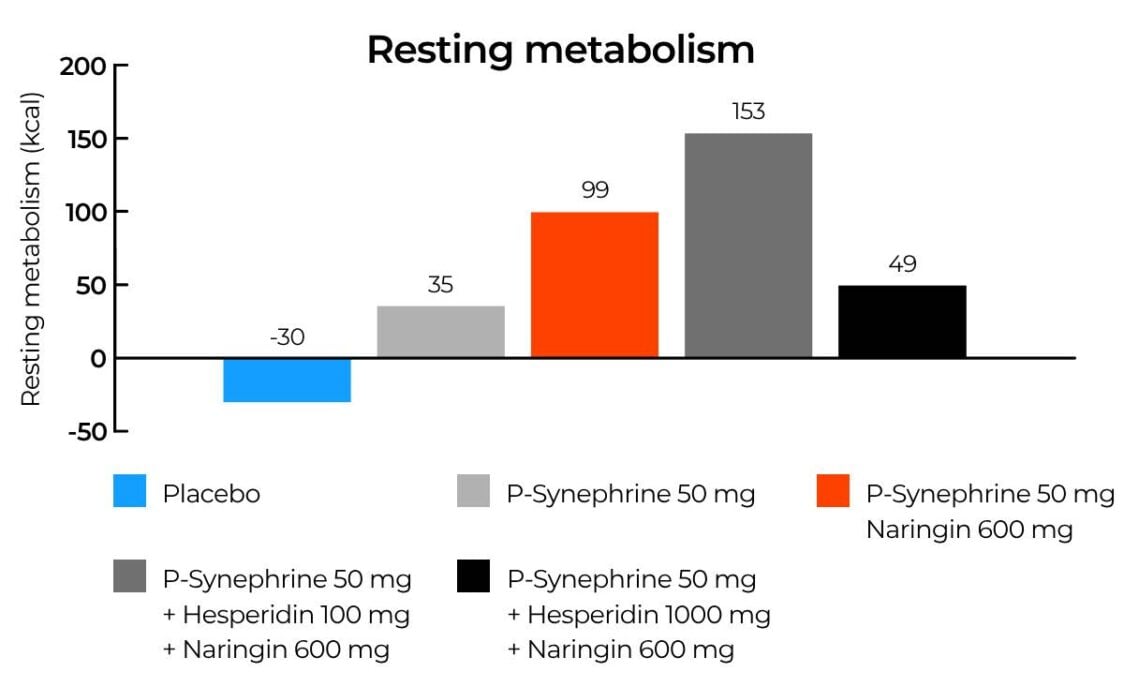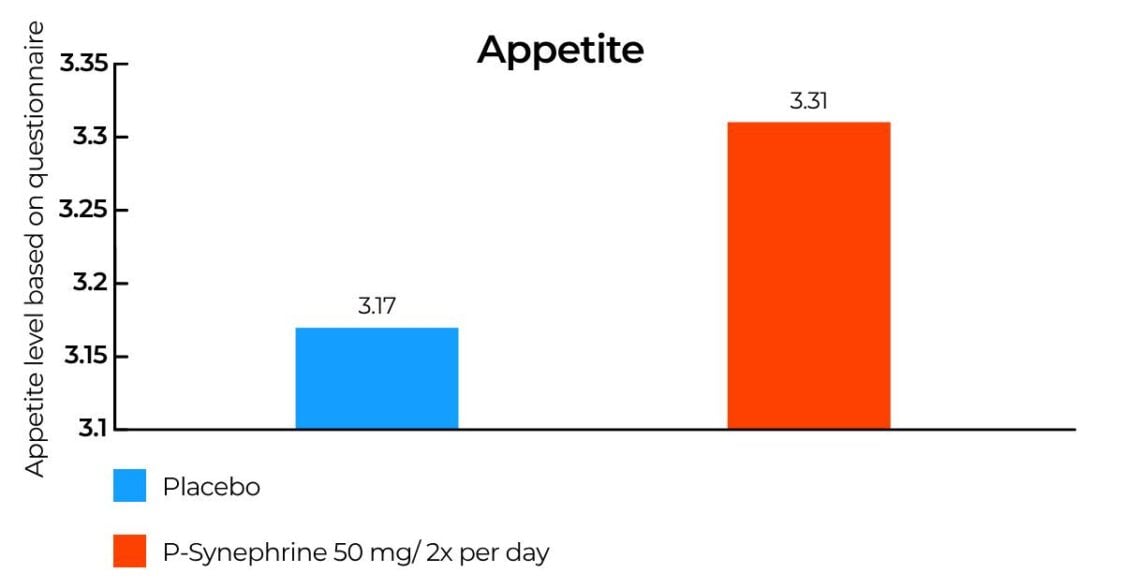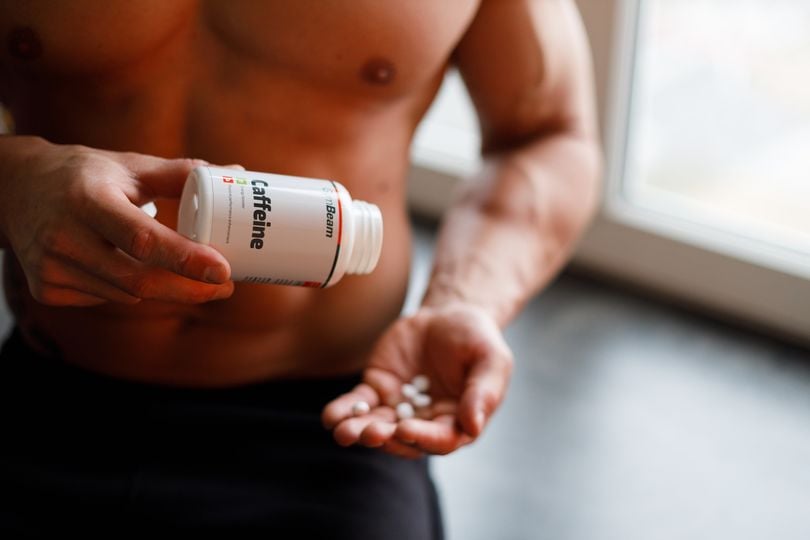Table of Contents
Synephrine has long been known in the field of traditional Chinese medicine. However, science began to look into it more intensively when ephedrine was banned due to its side effects. Gradually, its potential for weight loss or appetite control began to be revealed. So how does synephrine work and what are its effects?
What is synephrine?
Synephrine is an alkaloid that occurs naturally in some citrus fruits. However, its main source is the rind of the bitter orange (Citrus aurantium). The latter originally comes from Asia and has long been known in traditional Chinese medicine, where it has been used for digestive problems.
Bitter orange extract, which is standardised to p-synephrine, is commonly used today. This is the form of synephrine that is best known and its effects are most described. This alkaloid, similar in structure to adrenaline or the banned ephedrine, is now known mainly for its effects on metabolism and fat burning. It is therefore a common ingredient in fat burners and dietary supplements for weight loss. [1]

What are the effects of synephrine?
Synephrine has several promising effects, with perhaps among the most notable being its impact on metabolism and fat burning. However, there is still a lack of information and its overall effect on the body is unknown. Therefore, many more studies are still required to clarify its effect on the body and to help us understand its full potential. What do we currently know about synephrine?
1. Helps with burning fat and weight loss
One tablet of synephrine may not guarantee you a sculpted belly and a dream figure, like so many promise from Ozempic, but it turns out that it can still be a promising weight loss aid. In fact, according to research, it can probably help speed up metabolism and increase energy expenditure. [5]
This is because it seems to have an effect on increasing resting metabolic rate, which is the energy needed by the body during waking hours when we are without any physical activity. This is probably due to its thermogenic effect. This causes the body to produce more heat, which it has to get rid of as part of thermoregulation, which in turn costs the body some extra energy. Thus, synephrine may increase overall energy expenditure due to this effect. Scientists also hypothesise that synephrine could promote lipolysis itself, i.e. the breaking down and burning of fat. [5]
However, it seems to have the best effects when combined with other substances such as caffeine. The so-called synergistic effect plays a role in this. The effect of each substance is ultimately greater in this combination than it would be if used on its own. The effect of synephrine with caffeine, for example, is also described in a meta-analysis, which reports that 12 mg of synephrine combined with 300 mg of caffeine and 300 mg of EGCG increased metabolism by 9-13.5%, which was evident 2- 3 hours after administration. [6]
You might be interested in these products:
As seen by science: the effect of synephrine on resting metabolism
The action of p-synephrine to increase resting metabolic rate was demonstrated in a study that observed 50 participants. They were divided into five groups. All participants had their resting metabolic rate measured fasting and then 75 minutes after taking the prescribed combination of substances. One of the groups took a placebo, the second received 50 mg of p-synephrine, and the third group was prescribed 50 mg of p-synephrine and 600 mg of naringin. The other two took p-synephrine in combination with varying amounts of naringin and hesperidin. Naringin and hesperidin are among the flavonoids also native to citrus fruits that are likely to have an effect on, for example, lowering blood sugar or cholesterol levels. [7]
In a second measurement after 75 minutes, the researchers assessed how much the resting metabolic rate had increased on average in each group. [7]
The use of p-synephrine has been shown to increase resting metabolic rate compared to a placebo, by about 6.9% (about 65 kcal). However, an even greater increase occurred after taking the combination with naringin. The highest increase was when combined with both naringin and hesperidin. However, a dose of 1000 mg of hesperidin did not have such a large effect. [7]

- Read more about dietary supplements that can help you lose weight in our article Dietary Supplements for Weight Loss: Which Ones Are Good for Burning Fat or Feeling of Satiety?
- Our article Calorie Deficit: How to Lose Weight and Have a Life? will help you to create a diet that will help you achieve a calorie deficit.
2. Supports athletic performance
Synephrine is also used as an ingredient in pre-workout stimulants, due to its potential impact on supporting athletic performance. It is not known exactly how it works, but several different mechanisms may be behind it. For example, this substance is likely to increase the breakdown of glycogen to glucose (glycogenolysis) in the liver and, in addition, promote the supply of glucose to muscle cells. At the same time, it also appears that it may promote the use of fat as an energy source for the muscles, i.e. it may help burn more energy from fat during exercise. Thus, muscles seem to have a higher energy intake and can perform better due to more available glucose and fat. [4]
Scientists also hypothesise that synephrine could have an effect on muscle contractility, or the ability of muscles to contract. [4]

How science sees it: the effect of synephrine on athletic performance
The association between synephrine use and athletic performance was investigated in a study with 12 participants (men) who had been involved in strength sports for at least 2 years prior. They were divided into four groups, with one group not taking anything, the second receiving a placebo, the third group taking p-synephrine (100 mg) and finally the fourth group supplementing with caffeine (100 mg) in addition to synephrine (100 mg). [4]
The researchers looked at the effect of taking these substances on strength performance, specifically the number of repetitions per squat. The experimental protocol consisted of 6 sets of squats with up to 10 repetitions per set with a load of 80% of maximum weight. The interval between sets was 2 minutes. It was found that participants in the groups receiving synephrine and synephrine with caffeine achieved a higher number of repetitions on average. [4]

The foundation of success in building strength and improving training performance is, of course, a quality training plan and well-adjusted nutritional plan. However, synephrine and similar substances can boost performance a little more. The following articles will explain how to create a good training plan:
- How to Create a Quality Gym Training Plan?
- How Many Reps Should You Do to Lose Weight or Gain Muscles?
Our article How to Choose and Use the Most Effective Pre-Workout Supplement? will help you choose the right one for you.
3. Affects appetite
Another of synephrine’s promising properties for the human body is probably its ability to act on neurotransmitters (molecules that carry information between cells) to target the centres in the brain that control appetite. This suppression in appetite may also be related to the possible antioxidant and anti-inflammatory effects of synephrine. [2]
How science sees it: the effect of synephrine on appetite
The link between synephrine and appetite control was evident in a study involving 40 people that lasted 30 days. Participants were divided into four groups and were asked to consume chewy lollies daily for one month, 15-30 minutes before their two largest meals of the day. Group A was given lollies containing 50 mg of p-synephrine (so they received 100 mg daily) and Group B consumed a placebo, a conventional lolly without the active ingredient. Groups A/B and B/A took one variant of the lollies for half the month and then the other. [2]
As a result of the study, Group A, which took synephrine, rated their hunger as milder compared to Group B, which received a placebo. Similar results were seen when the groups were switched between the lolly groups in the A/B testing. [2]

- Also, a well-constructed diet will help in preventing hunger and controlling appetite in the first place. You can read how to do this in our article How to Get Rid of Constant Hunger and Cravings?
- Our Appetite Control can help you fight sweet cravings, and it’s also worth reading our article 15 Easy Steps to Beat Sweet Cravings.
4. What other areas of health can it have an effect on?
These three effects of synephrine are among the most widely studied today, but there is also talk in scientific circles of its other promising properties. However, the evidence for these is still minimal.
- Bitter orange fruit extract containing synephrine could possibly have an effect on maintaining optimal blood sugar levels (glycaemia). [3]
- The effect of bitter orange extract on digestion is well known from traditional Chinese medicine. It has been used, for example, in connection with constipation or indigestion. [8]
- Bitter orange peel is also used for skin problems to reduce irritation or inflammation. However, this is an effect that is supported by minimal evidence.
How does synephrine work?
The main mechanism of action of synephrine is its action on β-3 adrenergic receptors. These are receptors in the wall of blood vessels that play a role in, for example, their dilation (vasodilation). Synephrine is thus able to influence the cardiovascular system through these receptors, for example by increasing blood pressure or heart rate. However, acting on these receptors also seems to have effects such as promoting lipolysis or reducing appetite. [1]
Synephrine is similar in structure to ephedrine, which was banned in 2004 due to its strong adverse effects on the cardiovascular system (high blood pressure or even heart attack). It was then that scientists turned their attention to synephrine, which also has a similar effect due to its comparable structure. However, its effects are not as strong and it is considered safe. Ephedrine binds to other receptors in blood vessels that elicit a stronger response than those on which synephrine acts. [3]

Can synephrine have side effects?
As mentioned above, synephrine acts through receptors in the vascular wall to stimulate the cardiovascular system. However, its effect is several degrees less than, for example, ephedrine or other ephedrine-like substances, and so it is generally considered safe. Nevertheless, adverse effects such as increased heart rate (tachycardia) or increased blood pressure have been reported. Obviously, this depends on everyone’s individual sensitivity. Therefore, it is advisable to consult a doctor about its use and also to follow the recommended intake. [3,5]
However, we are continuing to refer to the p-synephrine form. In fact, one of its other forms, methyl-synephrine, is known for its adverse effects and is even listed as a banned substance by the World Anti-Doping Agency. [10]
How do you use synephrine?
Different doses of synephrine have been reported in studies, but the most common range is from 25-100 mg. [3]
When taken regularly to support athletic performance or to improve weight loss, it is recommended to take 10 – 20 mg daily before physical activity. It is recommended that you should start taking lower doses, especially if you combine it with other substances. [9]
What can you combine synephrine with?
Synephrine is commonly used in combination with other substances with a stimulant effect. It is commonly found in fat burners or pre-workout boosters along with caffeine, green tea extract containing EGCG (epigallocatechin-3-gallate), forskolin, hesperidin or naringin. Also, well known is a combination of thermogenic stimulants called ECA, which contains caffeine, synephrine and salicin in a 20:1:1 ratio. These substances complement each other thanks to their synergistic effect.
What might an effective combination of these substances look like?
The combinations of substances in the individual products vary, but an advantageous combination may for example look like the following.
- 20 mg synephrine
- 200 mg caffeine
- 400 mg EGCG
- 100 mg of forskolin
It is certainly advisable to be cautious in the beginning. Each of you has different sensitivities to these substances, and it may happen that something that will have a minimal effect on one will have a much more pronounced effect on the other. It is therefore ideal to start with lower doses and increase them gradually. [9]
However, don’t forget that fat burners are just the icing on the cake when you’re trying to lose weight and sculpt your physique. The key is always a calorie deficit and a well-balanced diet with optimal amounts of all important nutrients. For example, our Online Energy and Macronutrients Calculator and our article What is a Healthy Diet and How to Learn to Eat Healthily? can help you create one.

What should you remember?
Today, synephrine is mainly encountered in the form of dietary supplements that are designed to support athletic performance or weight loss. In fact, it has been shown that it can accelerate metabolism, promote fat burning or even suppress appetite. Although a lot of scientific research is still needed to clarify how it works, it can now be said that it is generally considered safe by scientists. Together with other active ingredients, it can be a good aid in sports or weight loss.
Has the article taught you anything new and interesting? Don’t forget to show it with your friends and support us by sharing it.
[1] GARDY, S. Bitter orange Research Analysis. – https://examine.com/supplements/bitter-orange/
[2] KAATS, G.R. et al. Increased eating control and energy levels associated with consumption of bitter orange (p-synephrine) extract: a randomized placebo-controlled study. – https://www.tandfonline.com/doi/full/10.2147/NDS.S136756
[3] KONCZ, D. et al. The Safety and Efficacy of Citrus aurantium (Bitter Orange) Extracts and p-Synephrine: A Systematic Review and Meta-Analysis. – https://www.mdpi.com/2072-6643/14/19/4019
[4] RATAMESS, N.A. et al. The effects of supplementation with P-Synephrine alone and in combination with caffeine on resistance exercise performance. – https://www.tandfonline.com/doi/full/10.1186/s12970-015-0096-5
[5] RUIZ-MORENO, C. et al. Effects of p-Synephrine during Exercise: A Brief Narrative Review. – https://www.mdpi.com/2072-6643/13/1/233
[6] STOHS, S.J. et al. A Review of the Human Clinical Studies Involving Citrus aurantium (Bitter Orange) Extract and its Primary Protoalkaloid p-Synephrine. – https://www.ncbi.nlm.nih.gov/pmc/articles/PMC3444973/
[7] STOHS, S.J. et al. Effects of p-synephrine alone and in combination with selected bioflavonoids on resting metabolism, blood pressure, heart rate and self-reported mood changes. – https://pubmed.ncbi.nlm.nih.gov/21537493/
[8] STOHS, S.J. Safety, Efficacy, and Mechanistic Studies Regarding Citrus aurantium (Bitter Orange) Extract and p‐Synephrine. – https://www.ncbi.nlm.nih.gov/pmc/articles/PMC5655712/
[9] Fat Loss - Supplement Guides on Examine. – https://examine.com/guides/fat-loss/
[10] The Prohibited List | World Anti Doping Agency. – https://www.wada-ama.org/en/prohibited-list


Add a comment